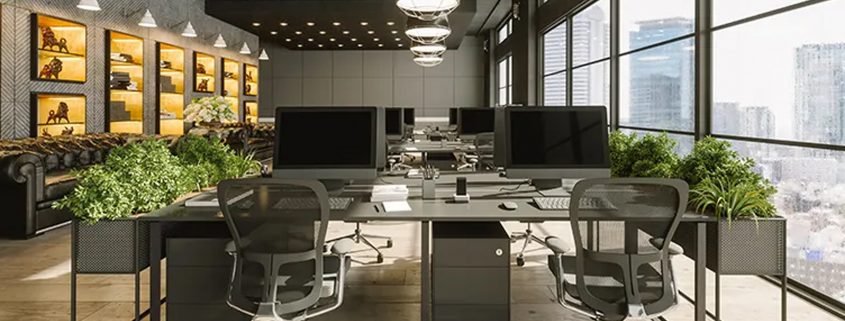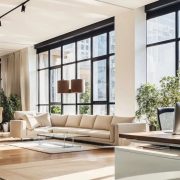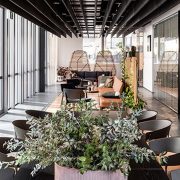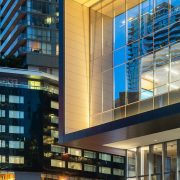Sustainable Workspace Design
In the recent Gensler The Return of the City retrospective, Austin was described as the 11th largest city in the United States and one of the most rapidly growing metropolitan areas. However, Austin’s explosive growth and increasing rents have begun to price out portions of the city’s foundational artistic community. Six million square feet of new office space will become available within the next decade, the fastest rate for office market growth on the continent. Many of these buildings have been designed to appeal to young workers as one-stop complexes, providing a singular destination for working, living, shopping, and recreation. To further the city’s resilience, Austin’s economic development agency pledged $35 million toward recruiting emerging industries, attracting global markets, filling the talent pipeline, and improving quality of life. Austin’s commitment to sustainability makes it imperative that more commercial spaces focus on resilient design. How can we make this a more sustainable long-term solution in the workplace?
IS THE DESIGN INDUSTRY DOING ENOUGH?
Reduce, reuse, and recycle are not new concepts. They are the guiding principles for third-party sustainability certifications, like LEED, and can be applied to workplaces of the future to meet new, more challenging goals that will help alleviate the effects of climate change. By consistently integrating these core concepts into each step of the design process, from concept to occupancy, more resilient, sustainable workplaces can be created. However, reaching Net Zero carbon emissions will require offices to operate above and beyond current jurisdictional energy codes.
Combatting climate change is a multifaceted challenge that demands a dynamic and tailored approach from design teams. Successful projects integrate a range of innovative, sustainable solutions that are responsive to an owner’s goals, project location, community needs and preferences, locally available materials, and more. Often teams focus on the initial design of the base building. Interior renovations, which happen multiple times through the lifecycle of a facility, can be just as impactful if the right strategies are enacted.
PASSIVE DESIGN
Passive design is the holy grail for the reduction of carbon emissions. At its core, passive design reduces a building’s energy demand, but it can also significantly increase the adaptability and resilience of a space. Over the last decade, designers have developed and refined techniques that allow teams to optimize local climate conditions to reduce the need for artificial or mechanical climate control. Solutions that effectively prioritize natural ventilation, maximize natural light and utilize a building’s mass as thermal storage enables teams to achieve impactful sustainability goals and mitigate climate change.
REDUCE
Passive design strategies can enhance the workplace environment with features like natural ventilation which reduces the reliance on HVAC systems and exterior shading devices to mitigate solar heat gain and glare. These have proven to be attractive, low-cost approaches to reducing energy consumption alongside:
- Renewable energy technologies, on-site or off-site can diminish carbon emissions.
- Tree and plant-rich terraces and courtyards remove CO2 from the surrounding air while providing a connection to nature.
- Reclaimed and repurposed materials substantially reduce embodied carbon.
- Reusing or repurposing existing building materials (flooring, ceilings, walls, fixtures, and furnishings) can also eliminate the energy-intensive burden of extraction, manufacturing, and transportation.
- Energy Star certified equipment and appliances with timers or occupancy sensors help reduce plug load demand, leveraging building systems with renewable energy.
- Utilizing LED fixtures, occupancy, and daylight harvesting sensors can reduce Lighting Power Density (LPD) and lower operational carbon emissions.
REUSE
Maximizing the reuse of existing hard-walled construction and infrastructure can reduce the demand for new materials, which lessens the impact of embodied carbon required for a minor renovation versus extensive demolition and new construction. This strategy is an attractive option from a sustainable mindset and from a financial perspective with the cost-savings achieved by reducing the construction timeline. Other reuse strategies include:
- Refurbishing existing furniture significantly reduces embodied carbon in the workplace.
- Adaptive reuse alongside reclaimed materials aligns with the principles of a circular economy.
- Revitalizing existing structures fosters pride within a neighborhood by enabling a shared community.
- Adaptive reuse helps mitigate urban sprawl by revitalizing existing spaces and promoting infill development.
- Salvaging and reusing materials can reduce embodied emissions by as much as 50% for retrofits and 99% for new construction.
- Reusing/repurposing existing building materials such as flooring, ceilings, walls, fixtures, and furnishings eliminates the energy-intensive burden of extraction, manufacturing, and transportation.
- Utilizing repurposed materials through Urban design brings a level of enhanced sophistication and character to a finished space.
RECYCLE
Interior finish materials that are renewable or have high recycled content are beneficial because they reduce our reliance on natural resources. Many office furniture manufacturers now utilize sustainable/renewable materials in chairs and office systems:
- Integrating reused or upcycled products makes for unique expressions in the workplace to support zero-waste initiatives.
- Renewable finishes with high-recycled content reduce reliance on natural resources.
- Holistically applying reduce, reuse & recycling strategies positively impacts designing efficient, low-carbon spaces.
- Wood is one of the must sustainable and renewable materials because it naturally sequesters carbon.
- Fabrics and carpets made from recycled plastics can provide another level of sustainability by design.
FLEXIBLE WORKSPACES
Thinking differently creates different results. As flexible workspaces become the norm mobile furniture and de-constructible design elements become more prominent. Demountable partitions, movable walls, or partitions minimize material waste during demolition and construction and promote adaptability, allowing spaces to evolve with changing needs without requiring extensive renovations. Glass walls can significantly change the look of a space while also making more natural light available across the entire workspace.
Elongating the life cycle of products and materials significantly reduces the environmental impact of construction waste, which is estimated to exceed 145 million tons annually in the US. By recycling materials, we can prevent the release of harmful chemicals and toxins into the environment and destroying air, soil, and water resources.
TOP BRANDS
Designing a workplace to be sustainable minimizes the negative effects on the environment while conserving resources by making smart and efficient use. Pushing an office to be more environment-friendly and energy-efficient includes small steps, like using sustainable materials, harvesting natural energy (in the form of natural light and ventilation), and having energy-efficient systems that rely majorly on renewable resources without exploiting them. Ask our design team about this approach. This is a way to future-proof your office design. Some of the top sustainable furniture brands we acquire are listed below, if you are interested contact us:
 OUR PROJECT MANAGEMENT TEAM can help you discover, prioritize and visualize these changes with a variety of tools and methodologies to assist with design upgrades and reconfigurations. Contact our sales team for guidance at 512-448-3769 or experts@officefurniturenow.com
OUR PROJECT MANAGEMENT TEAM can help you discover, prioritize and visualize these changes with a variety of tools and methodologies to assist with design upgrades and reconfigurations. Contact our sales team for guidance at 512-448-3769 or experts@officefurniturenow.com






